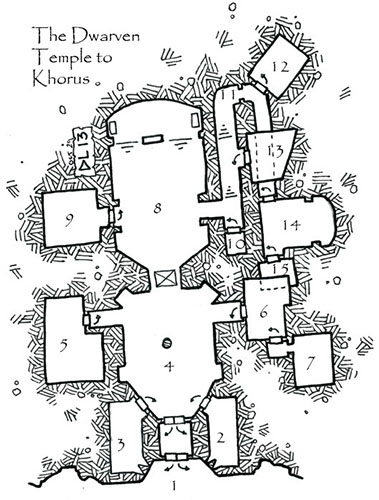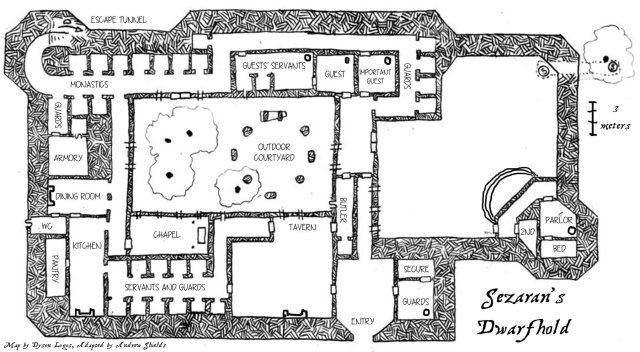Half a decade ago, a fellow named FireLance posted a really interesting breakdown of non-combat challenges over at ENWorld in a post that got, apparently, no attention whatsoever. Which is unfortunate, because I think it’s actually a really interesting way of looking at non-combat encounters.
Before delving into it, though, I should note that this is a lot like the “36 Dramatic Situations” or “7 Basic Plots” or “20 Master Plots” lists that periodically go floating through the meme-verse: These are useful as conceptual tools, but you shouldn’t get too wrapped up in believing the reductivist perception of the creative process they maintain. If you believe that The Terminator and Hamlet are both the same story because they can be boiled down to “Man vs. Man”, then you’re making the same categorical error as believing that the Grand Canyon and your garden are the same thing because they can both be categorized as “earth”.
Tossing that proviso aside, however, I’m going to briefly restructure and revisit FireLance’s basic work.
DISCOVERY CHALLENGES
Discovery challenges involve seeing, finding, or becoming aware of something that was previously lost or unknown.
TYPES OF DISCOVERY CHALLENGES
Knowledge: Determining whether or not a PC already knows a piece of information.
Invention: The creation or revelation of new knowledge. (This can also include the creation or repair of physical objects.)
Observation: Determining whether or not a PC notices something hidden (an object, a person, an intent, a clue, a pattern).
Research: Exploring existing sources of knowledge to discover the information (databases, libraries, warehouses).
Tracking: Discovering the location of a creature or object by following a trail of observations.
DISCOVERY CHALLENGE COMBINATIONS
Movement challenges contribute to Discovery challenges if being in a particular location makes its easier (or necessary) for the PCs to observe or discover something.
Persuasion challenges contribute to Discovery challenges if the knowledge sought by a PC is possessed by an NPC.
Survival challenges may contribute to a Discovery challenge if some information can only be found or pursued in a dangerous location.
MOVEMENT CHALLENGES
Movement challenges involve reaching a particular location. Such challenges can be broadened by including additional characters, creatures, or objects that must be moved along with the PC (e.g., clearing a pile of stones, guiding a group of pilgrims, helping someone climb a wall).
TYPES OF MOVEMENT CHALLENGES
Chase: The PC must arrive at a location before a certain time or before someone/something else does. (Or, alternatively, they must stay ahead of a pursuer.)
Obstacle Course: The PC must traverse some form of physical obstacle in order to reach their destination (e.g., climbing, jumping, swimming, balancing, opening locks, moving heavy boulders).
Sneak: The PC must evade discovery.
MOVEMENT CHALLENGE COMBINATIONS
Discovery challenges contribute to Movement challenges if the discovery makes the movement easier (e.g., providing a short cut, an easier method of travel, or the like).
Persuasion challenges contribute to Movement challenges if the journey requires the PCs to handle mounts, convince NPCs to allow them passage, or if they have to bring NPCs with them.
Survival challenges contribute to Movement challenges if the PCs have to travel through a dangerous area.
PERSUASION CHALLENGES
Persuasion challenges are focused on convincing another person (or group of people) to take a particular course of action.
TYPES OF PERSUADE CHALLENGES
The full gamut of potential social situations allows for a wide variety of potential goals for Persuasion challenges (literally anything a person could know or do for you) and also a wide variety of potential tactics (seducation, coercion, intimidation, flattery, bribery, etc.), but ultimately they are all challenges of the same type despite this vast panoply of possible variations.
PERSUADE CHALLENGE COMBINATIONS
Discovery challenges can contribute to Persuasion challenges by providing leverage over someone (or, perhaps, removing the leverage that someone else has over them).
Movement challenges contribute to Persuasion challenges by giving access to the person you need to persuade.
Survival challenges contribute to Persuasion challenges by keeping people alive until they can do what you want them to do.
Any challenge type can contribute to a Persuasion challenge if it’s being carried out in exchange for a person’s cooperation.
SURVIVAL CHALLENGES
Survival challenges involve characters escaping or enduring physical danger (or helping others escape or endure physical danger). They could also feature the prevention of potentially dangerous situations (like negating a ritual that would summon a demon).
TYPES OF SURVIVAL CHALLENGES
Environmental: Dangerous weather, natural disasters, extreme temperatures, poisonous gases, inimical energies, or any other pervasive hazard.
Health: Recovering from diseases, long-term poisons, curses, or other afflictions. Also enduring shortages in the essentials of life (food, water, oxygen, etc.).
Trap: Hidden hazards unleashed by specific triggering conditions. Traps can generally be disabled so that they no longer pose a threat. (They are usually contrivances created by an intelligent creature with the intention of snaring the unwary, but certain natural hazards may also possess some or all the characteristics of a trap.)
SURVIVAL CHALLENGE COMBINATIONS
Discovery challenges contribute to Survival challenges by giving advance warning of danger or methods of surviving or bypassing the danger.
Movement challenges contribute to Survival challenges by allowing a character to reach a safe area.
Persuasion challenges contribute to Survival challenges if someone is convinced to help the PC survive.
USING THE ABSTRACTION
As a GM, what I generally find these types of categorical analyses most useful for is self-diagnostics: Am I defaulting to a particular type of challenge too often? Is there a type of challenge that I’m usually not including in my scenarios? Are there ways that I could be combining multiple challenge types in interesting ways?
What I don’t recommend doing, however, is designing directly from the abstraction: Thinking something like “OK, I need a Survival challenge of the Trap variety here” is, ironically, a trap itself. As anything other than a creative exercise, that sort of thinking will throttle your creativity and is also likely to artificially restrict you into thinking there’s a “right” way to resolve a given challenge.
On the other hand, that’s a good self-diagnostic exercise to perform: Look at an obstacle you’ve created in your current scenario and think about all the way different ways that someone could overcome or avoid or subvert that obstacle.
For example: Duke Leonardo has ordered the arrest of the PCs for a murder they didn’t commit. The obvious solution is a Movement challenge with the PCs trying to evade the guards or escape the city. But the PCs could also resolve it as a Persuade challenge (bribing guards or even convincing the Duke of their innocence). Or as a Discovery challenge (where they discover the true identity of the killer).
(Which isn’t to say that every challenge needs to be designed with liberal solutions in mind. Sometimes a trap is just a trap… unless, of course, the PCs find the architect who built the dungeon and convince him to give them the construction blueprints.)















